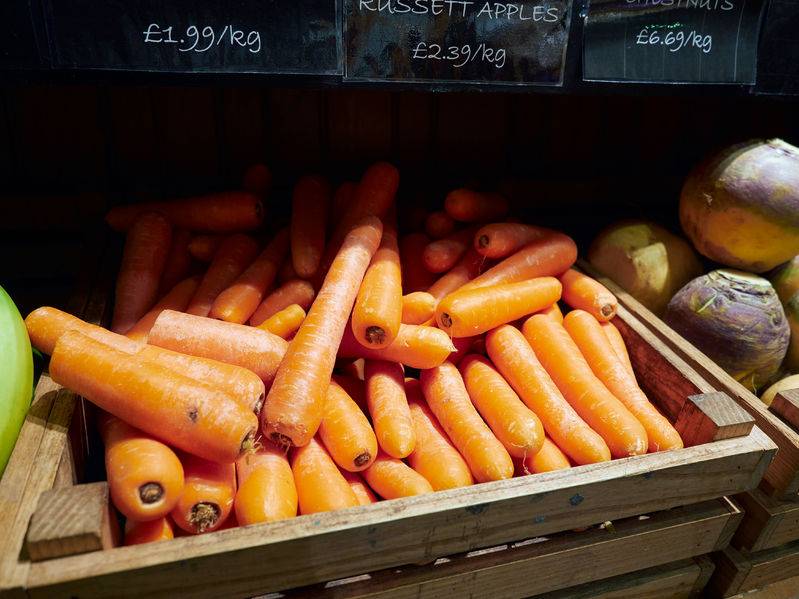
Vegetable exports hit a record high last year, according to figures released by the Defra - but were still dwarfed by the volume of imports into the UK.
According to the Horticulture Statistics report for 2016, exports were up 13 per cent compared with the previous year.
The exports were worth more than £109 million, according to the report's authors, the highest export value on record.
Fruit exports also recorded a big increase - up by 17 per cent to £116 million. This was the third consecutive increase by value.
But both vegetable and fruit exports were still small in comparison to both the volume and value of produce imported into the UK.
Vegetable imports amounted to £2.3 billion by value in 2016 - an increase of 11 per cent on 2015. Imports were up 5.1 per cent by volume.
Fruit imports recorded an even bigger increase. Fruit shipped to the UK was worth £3.6 billion in 2016 - up 18 per cent on the previous year. Volume was up by 4.4 per cent.
EU and South Africa
Most of the big exporting countries to the UK were members of the European Union, according to the report.
A third of the vegetable imports, mainly tomatoes, lettuce, cauliflower and broccoli, and 21 per cent of the fruit imports, citrus fruit, grapes and strawberries, came from Spain.
The Netherlands accounted for 25 per cent of vegetable imports, mainly tomatoes and sweet peppers, and the Irish republic accounted for 5.4 per cent of vegetable imports, mainly mushrooms.
The main non-EU exporting country mentioned in the report was South Africa. It accounted for 11 per cent of fruit imports, mainly grapes, citrus fruit and apples.
According to the report, home produced vegetables were worth £1.3 billion in 2016 - an increase of 7.5 per cent on the previous year, although overall production fell by 5.2 per cent. There was an increase in the value of field vegetables - up 12 per cent from £883 million in 2015 to £900 million in 2016.
The report's authors said: "At the start of 2016, conditions for growers were very good and parts of the UK started drilling very early.
"However, the weather conditions changed and hampered the progress of planting and crop development of spring established crops. The overall impact was a delayed start to the harvest of early crops and reduced head size for autumn and winter brassica."
Cucumber production down
Field vegetable production fell by 5.6 per cent from 2.5 million tonnes to 2.3 million tonnes in 2016, with the area of vegetables falling by 5.8 per cent.
The value of protected vegetables fell by 3.5 per cent from £365 million to £353 million. "Good weather conditions in the early spring gave a boost to early production. But the cooler and duller weather conditions over the summer reduced production during peak periods of consumer demand," said the authors.
"Cucumber production continues to decline in the UK as growers are switching to other crops."
The UK was 54 per cent self sufficient in vegetables in 2016, according to the figures. This was down by 4.6 per cent on the previous year.
Actual home production fell by 5.2 per cent to 2.6 million tonnes, although the report's authors said that, over the last 20 years, total production of vegetables had remained fairly constant between at 2.5 and 3.0 million tonnes.
Home production as a percentage of total supply of carrots and cabbages was over 90 per cent in 2016 - down slightly on 2015. Home production as a percentage of total supply of tomatoes was down by just over half a per cent compared with 2015 at 20 per cent.
Cold spring
Home produced fruit fell in value to £670 million from £695 million the previous year - a fall of 3.7 per cent compared to 2015, although production remained constant.
The decline in value followed three years of growth in both value and production for UK fruit growers.
"The fall in value was largely driven by price, with a fall in the value of soft fruit due to a later start to the soft fruit season and a fall in production when compared to 2015," said the authors.
"The cold spring led to later crop development and harvesting for all fruit. The cooler spring weather affected pear blossom more than apple blossom that flowered in good weather in early May. The cooler, duller summer led even growing conditions for strawberries and raspberries and the avoidance of over supply in production."
The area total for fresh fruit in 2016 remained similar to previous years at around 30 thousand hectares. And glasshouse fruit rose in value by 2.7 per cent in 2016 to £53 million, according to the figures.
